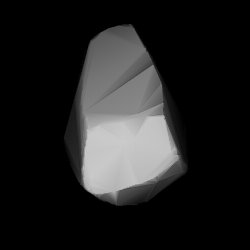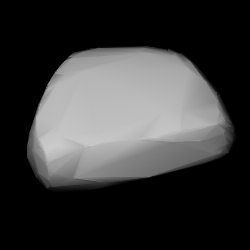1313 Berna, provisional designation 1933 QG, is a background asteroid and synchronous binary system from the Eunomian region in the central asteroid belt, approximately 14 kilometers in diameter. It was discovered on 24 August 1933, by Belgian astronomer Sylvain Arend at the Uccle Observatory in Belgium. The assumed S-type asteroid has a longer-than average rotation period of 25.5 hours and is likely elongated in shape. It was named for the Swiss capital of Bern. The discovery of an 11-kilometer-sized companion was announced in February 2004.

1039 Sonneberga, provisional designation 1924 TL, is a dark background asteroid, approximately 34 kilometers in diameter, located in the central region of the asteroid belt. It was discovered on 24 November 1924, by German astronomer Max Wolf at Heidelberg Observatory in southwest Germany. The asteroid was named for the German city of Sonneberg, where the Sonneberg Observatory is located.
6433 Enya, provisional designation 1978 WC, is a stony background asteroid from the inner regions of the asteroid belt, approximately 7 kilometers in diameter. It was discovered on 18 November 1978, by Czech astronomer Antonín Mrkos at the Kleť Observatory in the Czech Republic. It was named for Irish musician Enya.
1123 Shapleya, provisional designation 1928 ST, is a stony Florian asteroid from the inner regions of the asteroid belt, approximately 11 kilometers in diameter. It was discovered on 21 September 1928, by Russian astronomer Grigory Neujmin at Simeiz Observatory on the Crimean peninsula. It was named after American astronomer Harlow Shapley.
2751 Campbell, provisional designation 1962 RP, is a stony Nysian asteroid from the inner regions of the asteroid belt, approximately 6 kilometers in diameter.
6398 Timhunter, provisional designation 1991 CD1, is a stony Phocaea asteroid from the inner regions of the asteroid belt, approximately 5.5 kilometers in diameter. It was discovered on 10 February 1991, by American astronomer couple Carolyn and Eugene Shoemaker, in collaboration with Canadian astronomer David H. Levy at Palomar Observatory in California, United States. It was named for American amateur astronomer Tim Hunter.
3567 Alvema, provisional designation 1930 VD, is a dark asteroid from the middle region of the asteroid belt, approximately 14 kilometers in diameter. It was discovered by Belgian astronomer Eugène Delporte at the Royal Observatory of Belgium in Uccle, on 15 November 1930. It was named after the discoverer's three great-granddaughters Aline, Vérionique and Martine.
1651 Behrens, provisional designation 1936 HD, is a stony Florian asteroid from the inner regions of the asteroid belt, approximately 10 kilometers in diameter. Discovered by Marguerite Laugier in 1936, it was named after Johann Behrens.
2637 Bobrovnikoff, provisional designation A919 SB, is a background asteroid from the inner regions of the asteroid belt, approximately 6 kilometers in diameter. It was discovered on 22 September 1919, by German astronomer Karl Reinmuth at the Heidelberg-Königstuhl State Observatory in Heidelberg, Germany. The presumed spherical S-type asteroid has a rotation period of 4.79 hours. It is named after astronomer Nicholas Bobrovnikoff, who was the director of the Perkins Observatory in Ohio, United States.
24101 Cassini, provisional designation 1999 VA9, is an eccentric background asteroid from the middle region of the asteroid belt, approximately 7 kilometers in diameter. It was discovered on 9 November 1999, by American amateur astronomer Charles Juels at the Fountain Hills Observatory (678) in Arizona, United States. It was named after Italian–French astronomer Giovanni Cassini.
2939 Coconino, provisional designation 1982 DP, is a stony Nysian asteroid from the inner regions of the asteroid belt, approximately 6 kilometers in diameter. It was discovered on 21 February 1982, by American astronomer Edward Bowell at Lowell's Anderson Mesa Station in Flagstaff, United States. It is named after the Coconino County in Arizona.
1991 Darwin, provisional designation 1967 JL, is a stony Florian asteroid from the inner regions of the asteroid belt, approximately 5 kilometers in diameter.
1295 Deflotte, provisional designation 1933 WD, is a carbonaceous asteroid from the outer regions of the asteroid belt, approximately 48 kilometers in diameter. It was discovered on 25 November 1933, by French astronomer Louis Boyer at the Algiers Observatory in Algeria, North Africa. The asteroid was named after the discoverer's nephew.

1335 Demoulina, provisional designation 1934 RE, is a stony Florian asteroid from the inner regions of the asteroid belt, approximately 7 kilometers in diameter. Discovered by Karl Reinmuth at Heidelberg Observatory in 1934, the asteroid was named after Prof. Demoulin, a Belgian astronomer at Ghent University. It has a slower-than average spin rate of nearly 75 hours.
2571 Geisei, provisional designation 1981 UC, is a stony Florian asteroid from the inner regions of the asteroid belt, approximately 6 kilometers in diameter. It was discovered by Japanese astronomer Tsutomu Seki at Geisei Observatory on 23 October 1981, and named for the Japanese village of Geisei.
1405 Sibelius, provisional designation 1936 RE, is a stony Florian asteroid from the inner regions of the asteroid belt, approximately 8 kilometers in diameter. It was discovered on 12 September 1936, by Finnish astronomer Yrjö Väisälä at Turku Observatory in Southwest Finland. The asteroid was named after composer Jean Sibelius.
7776 Takeishi, provisional designation 1993 BF, is a background asteroid from the inner regions of the asteroid belt, approximately 6 kilometers in diameter. It was discovered on 20 January 1993, by Japanese astronomer Takeshi Urata at the Nihondaira Observatory in Japan. The assumed S-type asteroid has a rotation period of 8.9 hours. It was named after Japanese amateur astronomer Masanori Takeishi.
3823 Yorii, provisional designation 1988 EC1, is a carbonaceous asteroid from the outer region of the asteroid belt, approximately 11 kilometers in diameter.
4760 Jia-xiang, provisional designation 1981 GN1, is a background asteroid from the inner regions of the asteroid belt, approximately 5 kilometers (3 miles) in diameter. It was discovered on 1 April 1981, by astronomers at Harvard University's Oak Ridge Observatory in Massachusetts, United States. The presumed stony S-type asteroid was named after Chinese astronomer Zhang Jiaxiang. It has a rotation period of 14.96 hours.
2195 Tengström, provisional designation 1941 SP1, is a stony Florian asteroid from the inner regions of the asteroid belt, approximately 8 kilometers in diameter. It was discovered on 27 September 1941, by Finnish astronomer Liisi Oterma at Turku Observatory in Southwest Finland, and named for Swedish geodesist Erik Tengström.


